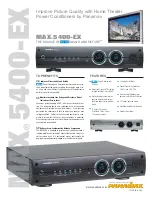
~ 31 ~
NOVATEK-ELECTRO
UBZ-304
Table 5.6
Command message
Code transferred,
HEX
Numbers for
LRC, HEX
STX
':'
3A
ADR
'0'
30
01
'1'
31
CMD
'0'
30
03
'3'
33
Start address of data
'2'
'1'
'0'
'2'
32
31
30
32
21
02
Number of data in words
'0'
'0'
'0'
'2'
30
30
30
32
00
02
LRC CHK 1
LRC CHK 0
'D'
'6'
44
36
END1
CR
0D
END2
LF
0A
5.4.4.3
Command of register entries
Command code
–
0x06, record
–
one word
This command is not recommended, as the entry of incorrect data may lead to failure of UBZ.
Data recording is possible at the addresses of programmable parameters (Table 3.6), except the parameters
listed in Table 5.7.
The parameter recording is independent of set protection of the advanced user (entry by the communication line
has higher priority).
When recording new value of the parameter into the cell protected by MNS, the parameter is automatically
removed from this mode.
Table 5.7
Settings and readings
Displaying
Address
Total time of the unit operation, day
Time UBZ
217
Motor operating time, day
Time motor
218
Access code of user
Users code
219
Access code of advanced user
Password
220
Restoration of factory settings
Default Factor
221
The unit design version
Version
230
Example: recoding order is 1000 (0x03E8) to register with address 0x00A0 to UBZ with communication address
01H in RTU mode is shown in Table 5.8.
Table 5.8
Command message
Response message
ADR
0x01
ADR
0x01
CMD
0x06
CMD
0x06
Start address of data
0x00
0xA0
Start address of data
0x00
0xA0
Data
0x03
0xE8
Data
0x03
0xE8
CRC CHK low
0x89
CRC CHK low
0x89
CRC CHK high
0x56
CRC CHK high
0x56
5.4.4.4
Command for diagnostics
Command code 08h
–
diagnostics
The 08h function provides a number of tests for checking the communication system between PC and UBZ, and
UBZ serviceability control.
The function uses the sub-function field to specify the action performed (test).
Sub-function 00h - return of request data
The data transmitted in the data field of the request should be returned in the response data field.
Example of request and response for MODBUS
RTU
mode is shown in Fig.5.13.









































